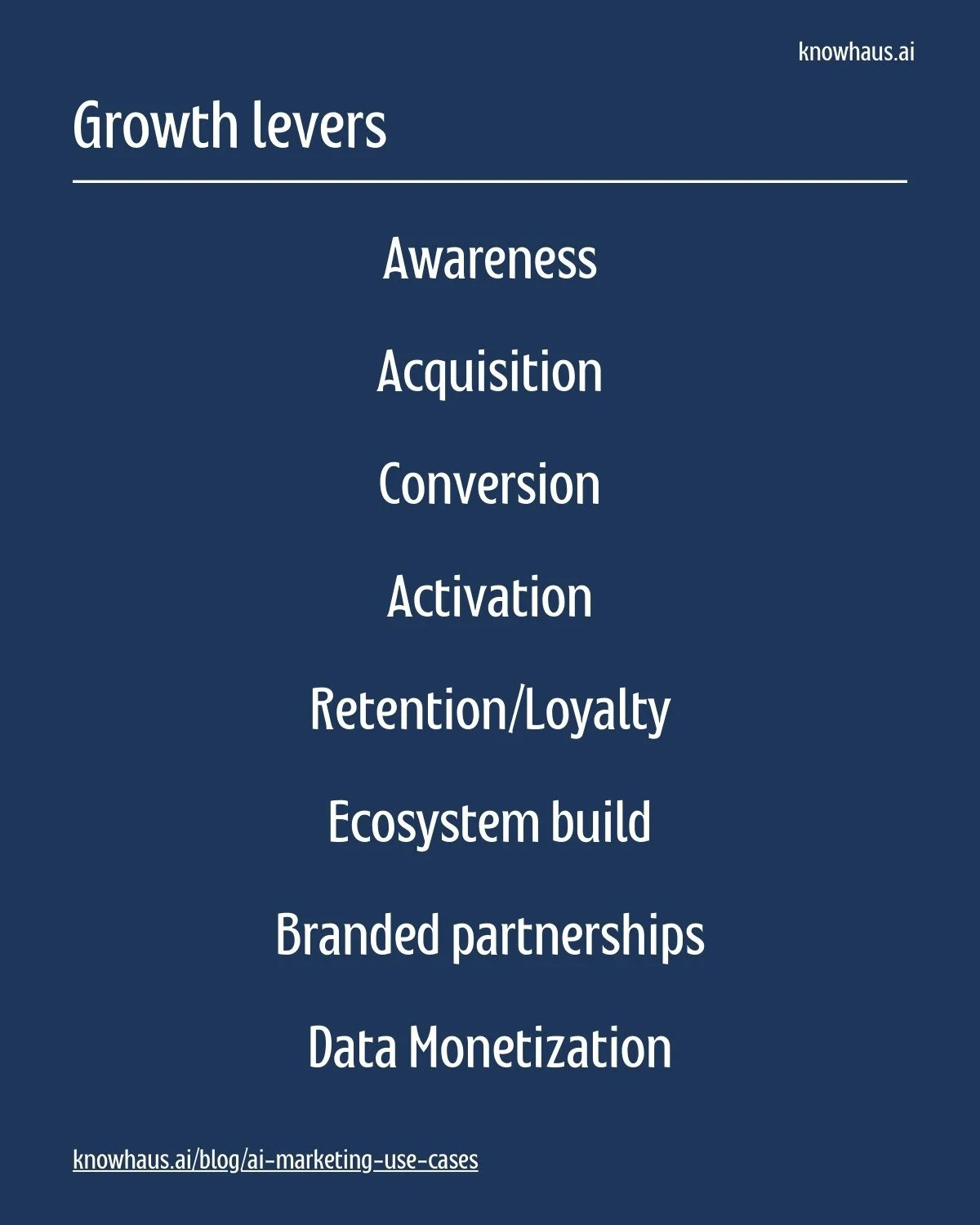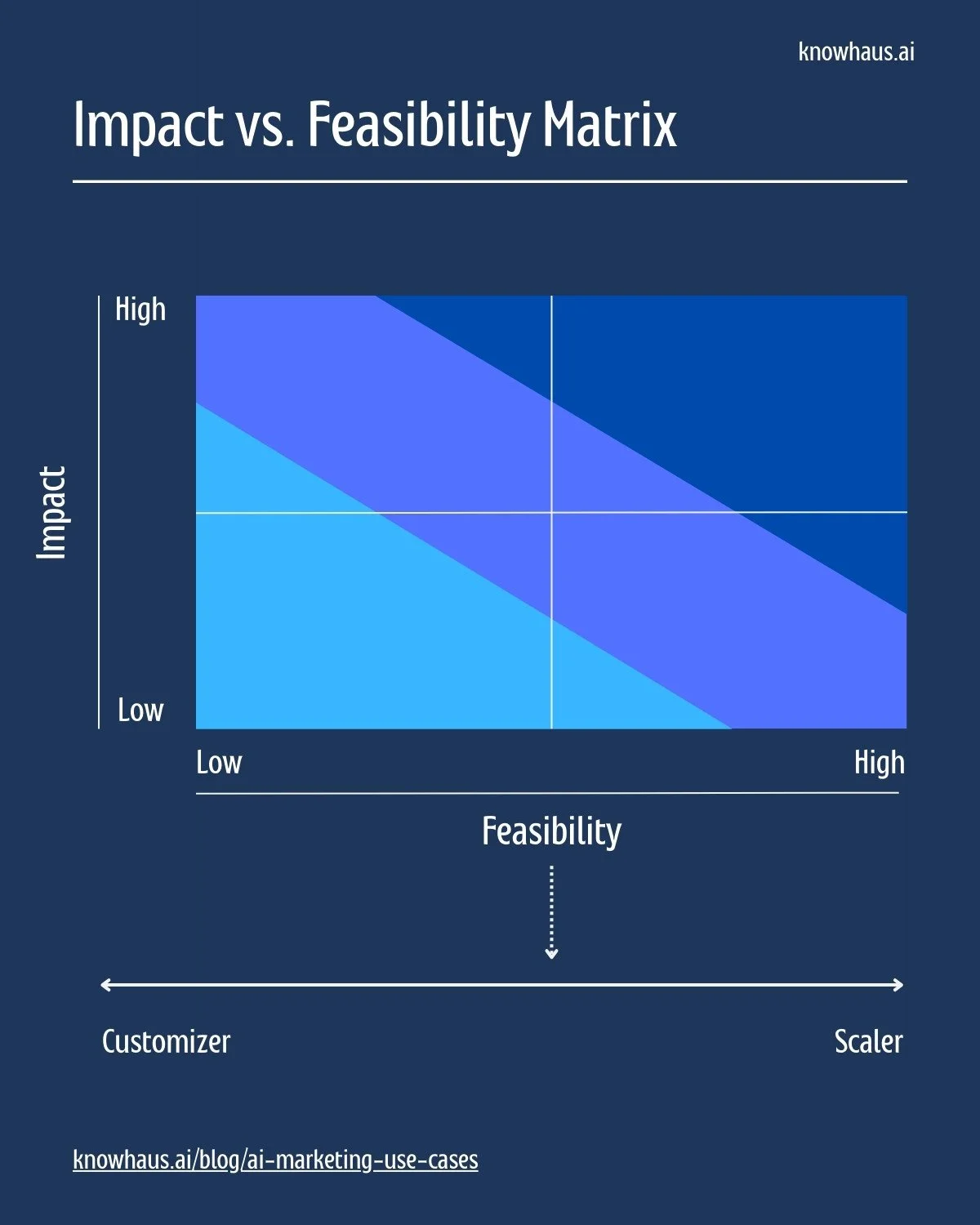AI Marketing Use Cases: How to Structure, Size, and Prioritize
Introduction
AI is transforming marketing by unlocking new efficiencies, improving customer experiences, and driving business growth. However, to maximize its potential, businesses must systematically structure, size, and prioritize AI marketing use cases. This post provides a framework to categorize use cases, measure their impact, and prioritize them using an impact-feasibility matrix—ensuring both immediate wins and long-term scalability.
1. Structuring AI Marketing Use Cases
To effectively implement AI in marketing, it's useful to categorize or annotate use cases across three dimensions: Media Value Chain, Growth Levers, and Data & AI Enablers.
1.1 Media Value Chain
AI can be leveraged at different stages of the media value chain, from audience insights to creative execution and campaign performance.
Key Components: Competitive research, audience insights, creative conception, content distribution, campaign performance measurement, risk & legal considerations.
Advantage: AI enhances productivity by automating content creation, optimizing media placements, and personalizing customer interactions.
Main Value Driver: Efficiency & cost savings – AI reduces manual effort, speeds up execution, and minimizes errors.
1.2 Growth Levers
AI-driven marketing can be mapped to different growth objectives, focusing on customer acquisition, retention, and monetization.
Key Components: Awareness, acquisition, conversion, activation, retention/loyalty, ecosystem building, branded partnerships, data monetization.
Advantage: AI-driven personalization and automation improve targeting, engagement, and conversion rates.
Main Value Driver: Revenue & margin uplift – AI helps businesses optimize marketing spend, increase conversion, and drive personalization.
1.3 Data & AI Enablers
Successful AI marketing initiatives require a strong foundation of data and AI capabilities.
Key Components:
Analytical AI: Structured customer data, engagement signals, predictive affinity scores.
Generative AI: Unstructured data processing, text and code generation, multi-modal content creation (image, video, audio).
Advantage: AI models process vast datasets to uncover patterns, predict customer behaviors, and generate high-quality marketing content.
Main Value Driver: Required enablers – AI’s effectiveness depends on high-quality data and strong analytical capabilities.
2. Impact Sizing Formulas
To justify AI investments, businesses must estimate the potential impact using three key formulas:
Revenue (or Margin) Impact Calculation
Revenue Impact = (Improvement in key metrics) × (Revenue per unit of improvement)
Example: If AI improves conversion rates by 5% and each 1% increase adds $10M in revenue, the total impact is $50M.
Cost Savings Calculation
Cost Savings = (AI efficiency gain) × (Cost reduction per unit gain)
Example: Automating content generation reduces human workload by 30%, saving $500K per year.
Return on Investment (ROI) Calculation
ROI = (Total business impact−Investment) / Investment
Example: If AI implementation costs $1M but generates $5M in impact, the ROI is 400%.
Impact sizing can be implemented through:
Benchmark-driven: Compare against industry best practices.
Target-driven: Set ambitious goals for improvement.
Test-driven: Use A/B testing to validate AI impact.
3. Prioritization with the Impact & Feasibility Matrix
Once AI marketing use cases are structured and sized, they should be prioritized using an Impact vs. Feasibility Matrix.
Understanding the Impact-Feasibility Tradeoff
Impact: How much value does the AI use case generate (e.g., revenue growth, cost reduction, efficiency gains)?
Feasibility: How complex is the implementation (e.g., required data, technical challenges, time to deploy)?
Balancing Customization vs. Scalability
Within feasibility, there’s a key tradeoff between Customizers and Scalers:
Customizer (Low Scalability, High Customization):
Solution is highly tailored for a specific use case or segment.
Pros: Quick wins, deeply personalized solutions.
Cons: Harder to scale, higher cost per deployment.
Example: AI-powered personalized product recommendations for a niche brand.
Scaler (High Scalability, Lower Customization):
Solution is designed for broad applicability across use cases or markets.
Pros: Enables long-term growth, standardization reduces cost over time.
Cons: Higher initial complexity, lower immediate impact in niche cases.
Example: A general brand LLM that can support a wide range of content creation tools.
Finding the Right Balance
If the goal is a quick, easy-to-deploy solution, prioritizing customization makes sense.
If the goal is long-term adaptability and scalability, investing in scalers early on is beneficial—even if it reduces short-term feasibility.
Final Thoughts
AI marketing presents huge opportunities, but businesses need a structured approach to maximize impact. By categorizing use cases, sizing their value with clear formulas, and prioritizing based on feasibility and impact, companies can build AI solutions that are both highly effective and scalable.
Would you like to explore specific AI marketing use cases for your business? Let’s connect!





